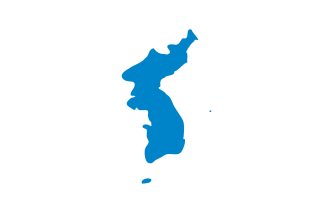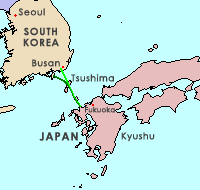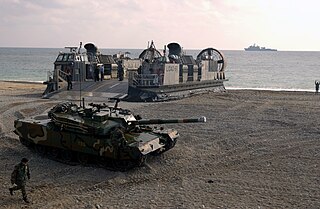Related Research Articles

Korean reunification is the hypothetical unification of North Korea and South Korea into a singular Korean sovereign state. The process towards reunification of the peninsula while still maintaining two opposing regimes was started by the June 15th North–South Joint Declaration in June 2000, was reaffirmed by the October 4th Declaration in October 2007 and the Panmunjom Declaration in April 2018, and the joint statement of United States President Donald Trump and North Korean leader Kim Jong Un at the Singapore Summit in June 2018. In the Panmunjom Declaration, the two countries agreed to work to officially end the Korean conflict in the future.

Syngman Rhee was a South Korean politician who served as the first president of South Korea from 1948 to 1960. Rhee is also known by his art name Unam. Rhee was also the first and last president of the Provisional Government of the Republic of Korea from 1919 to his impeachment in 1925 and from 1947 to 1948. As president of South Korea, Rhee's government was characterised by authoritarianism, limited economic development, and in the late 1950s growing political instability and public opposition.

The Kofun period is an era in the history of Japan from about 300 to 538 AD, following the Yayoi period. The Kofun and the subsequent Asuka periods are sometimes collectively called the Yamato period. This period is the earliest era of recorded history in Japan, but studies depend heavily on archaeology since the chronology of historical sources tends to be distorted. The word kofun is Japanese for the type of burial mound dating from this era.

A dispute exists over the international name for the body of water which is bordered by Japan, Korea and Russia. In 1992, objections to the name Sea of Japan were first raised by North Korea and South Korea at the Sixth United Nations Conference on the Standardization of Geographical Names. The Japanese government supports the exclusive use of the name "Sea of Japan", while South Korea supports the alternative name "East Sea", and North Korea supports the name "Korean East Sea". Currently, most international maps and documents use either the name Sea of Japan by itself, or include both the name Sea of Japan and East Sea, often with East Sea listed in parentheses or otherwise marked as a secondary name. The International Hydrographic Organization, the governing body for the naming of bodies of water around the world, in 2012 decided it was still unable to revise the 1953 version of its publication S-23 – Limits of Oceans and Seas, which includes only the single name "Sea of Japan", to include "East Sea" together with "Sea of Japan".
There are various names of Korea in use today that are all derived from those of ancient Koreanic kingdoms and dynasties. The choice of name often depends on the language, whether the user is referring to either or both modern Korean countries, and even the user's political views on the Korean conflict.

Baekje or Paekche was a Korean kingdom located in southwestern Korea from 18 BC to 660 AD. It was one of the Three Kingdoms of Korea, together with Goguryeo and Silla. While the three kingdoms were in separate existence, Baekje had the highest population of approximately 3,800,000 people, which was much larger than that of Silla and similar to that of Goguryeo.
The five kings of Wa were kings of ancient Japan who sent envoys to China during the 5th century to strengthen the legitimacy of their claims to power by gaining the recognition of a Chinese emperor during the chaotic period of the Northern and Southern dynasties, when either dynasty was desperate to gain legitimacy over the other by trying to assert itself as the granter of official titles, through garnering as many foreign countries willing to receive titles.
Korean nationalism can be viewed in two different contexts. One encompasses various movements throughout history to maintain a Korean cultural identity, history, and ethnicity. This ethnic nationalism was mainly forged in opposition to foreign incursion and rule. The second context encompasses how Korean nationalism changed after the partition in 1945. Today, the former tends to predominate.
The New Japan–Republic of Korea Partnership towards the Twenty-first Century was a declaration made on October 8, 1998, between Japanese Prime Minister Keizō Obuchi and South Korean President Kim Dae-jung to reconfirm friendly relations between Japan and South Korea, as well as declare that both countries will discuss the future of Japan-South Korea relations in order to build a new Japan–South Korea partnership. This declaration is also called the Japan–South Korea Joint Declaration of 1998.

Historic Relations: For over 15 centuries, the relationship between Japan and Korea was one of both cultural and economic exchanges, as well as political and military confrontations. During the ancient era, exchanges of cultures and ideas between Japan and mainland Asia were common through migration, diplomatic contact and trade between the two. Tensions over historic military confrontations still affect modern relations. The Mimizuka monument near Kyoto enshrining the mutilated body parts of at least 38,000 Koreans killed during the Japanese invasions of Korea from 1592 to 1598 illustrates this effect.
Japanese history textbook controversies involve controversial content in government-approved history textbooks used in the secondary education of Japan. The controversies primarily concern the nationalist right efforts to whitewash the actions of the Empire of Japan during World War II.

Mimana, also transliterated as Imna according to the Korean pronunciation, is the name used primarily in the 8th-century Japanese text Nihon Shoki, likely referring to one of the Korean states of the time of the Gaya confederacy. As Atkins notes, "The location, expanse, and Japaneseness of Imna/Mimana remain among the most disputed issues in East Asian historiography." Seth notes that the very existence of Mimana is still disputed.However, the hypothesis that Imna was a Japanese colonial ruling institution is being denied by the historical academia in Korea and Japan.

Diplomatic relations between South Korea and the United States commenced in 1949. The United States helped establish the modern state of South Korea, officially the Republic of Korea, and fought on its UN-sponsored side in the Korean War (1950–1953). During the subsequent decades, South Korea experienced tremendous economic, political and military growth.

Diplomatic relations between the Qing dynasty and the Korean Empire were established on September 11, 1899, but relations were halted in 1905 as a result of the Eulsa Treaty that made Korea a Japanese protectorate and which was then annexed by the Empire of Japan in 1910. Later, the Republic of China government recognized the formation of the Provisional Government of the Republic of Korea on April 13, 1919, as one of the participants of the Cairo Conference, which resulted in the Cairo Declaration. One of the main purposes of the Cairo Declaration was to create an independent Korea, free from Japanese colonial rule. Bilateral diplomatic relations between the Government of the Republic of Korea and the Republic of China were re-established in 1948, just after the foundation of the First Republic, hence making China, the first country to recognize the Republic of Korea as the sole legitimate government of Korea. During the Cold War, the People's Republic of China recognized only the Democratic People's Republic of Korea while South Korea in turn recognized only the Republic of China (Taiwan).

The Japan–Korea Undersea Tunnel, or Korea–Japan Undersea Tunnel, is a proposed tunnel project to connect Japan with South Korea via an undersea tunnel crossing the Korea Strait that would use the strait islands of Iki and Tsushima, a straight-line distance of approximately 128 kilometers (80 mi) at its shortest.

The China–Japan–South Korea trilateral summit is an annual summit meeting attended by the People's Republic of China, Japan and South Korea, three major countries in East Asia and the world's second, fourth and 12th largest economies. The first summit was held during December 2008 in Fukuoka, Japan. The talks are focused on maintaining strong trilateral relations, the regional economy and disaster relief.
The National Institute of Korean History is a South Korean government organization in charge of researching, collecting, compiling, and promoting materials related to Korean history. It was established as the Office of National History in March 1946, one year after the liberation of Korea. It changed its name to the current form in 1949.

Foal Eagle is a combined field training exercise (FTX) conducted annually by the Republic of Korea Armed Forces and the United States Armed Forces under the auspices of the Combined Forces Command. It is one of the largest military exercises conducted annually in the world. Foal Eagle has been a source of friction with the government of Democratic People's Republic of Korea (DPRK) and domestic ROK critics.

Some past and recent Koreans have claimed that Tsushima (対馬), a large island in the Korea Strait between the Korean peninsula and the Japanese island of Kyushu, has historically belonged to Korea. The island, which is known as Daemado (대마도) in Korean, has been controlled by Japan since at least the 8th century and is currently not officially claimed in any way by the governments of either South Korea or North Korea. However, some historic Korean governments have claimed that the island is rightfully theirs, and there have also been multiple unofficial attempts to assert a potential Korean claim in modern times.
Yamato Japan and the Gaya Confederacy, which were located directly across the Korea Strait from one another, had very close diplomatic and commercial ties since prehistory until the conquest of Gaya by Silla in 562 AD.
References
- 1 2 "Disclosure of the Report by the Japan-ROK Joint History Research Committee". MOFA. Retrieved 2012-09-03.
- ↑ "日韓歴史研究報告書の要旨 - 47News(よんななニュース)". Archived from the original on 2015-09-07. Retrieved 2015-11-01.
- ↑ "第1分科会(古代史)篇 | 公益財団法人 日韓文化交流基金 ウェブサイト". Archived from the original on 2015-07-10. Retrieved 2015-11-01.
- ↑ http://www.jkcf.or.jp/history_arch/second/1-05k.pdf [ dead link ]
- ↑ "Archived copy" (PDF). Archived from the original (PDF) on 2019-09-11. Retrieved 2015-11-01.
{{cite web}}: CS1 maint: archived copy as title (link) - 1 2 "Japan office never existed in 4th century-INSIDE Korea JoongAng Daily". Koreajoongangdaily.joinsmsn.com. 2010-03-24. Archived from the original on 2013-01-03. Retrieved 2012-09-03.
{{cite web}}: CS1 maint: unfit URL (link) - 1 2 "S.K.-Japan joint history project to be revived : International : Home". The Hankyoreh. 2007-04-26. Retrieved 2012-09-03.
- ↑ "Panel still bickers over history issues - English". The Asahi Shimbun . Retrieved 2012-09-03.